Download Near-Earth Asteroid Worksheets
Click the button below to get instant access to these premium worksheets for use in the classroom or at a home.
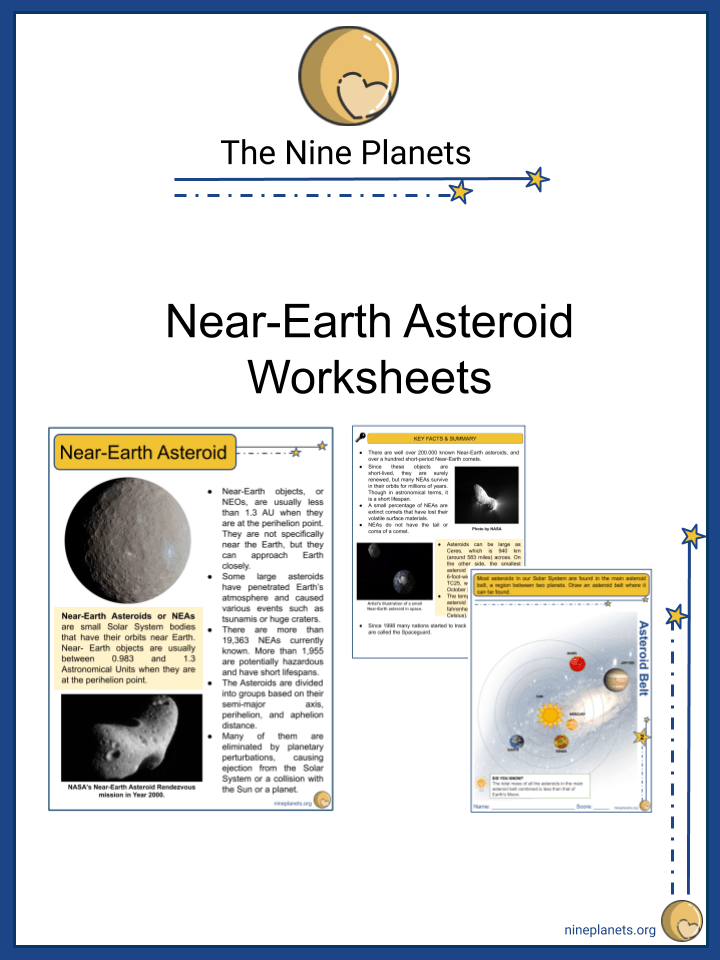
This worksheet can be edited by Premium members using the free Google Slides online software. Click the Edit button above to get started.
Download free sample
Not ready to purchase a subscription yet? Click here to download a FREE sample of this worksheet pack.
Resource Examples
Click any of the example images below to view a larger version.
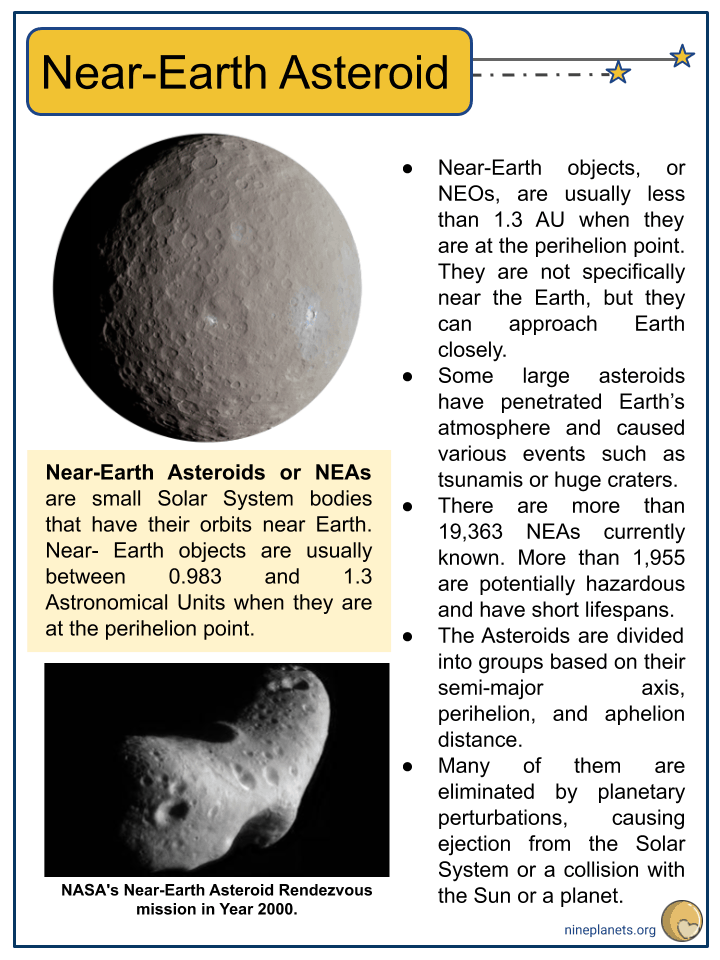
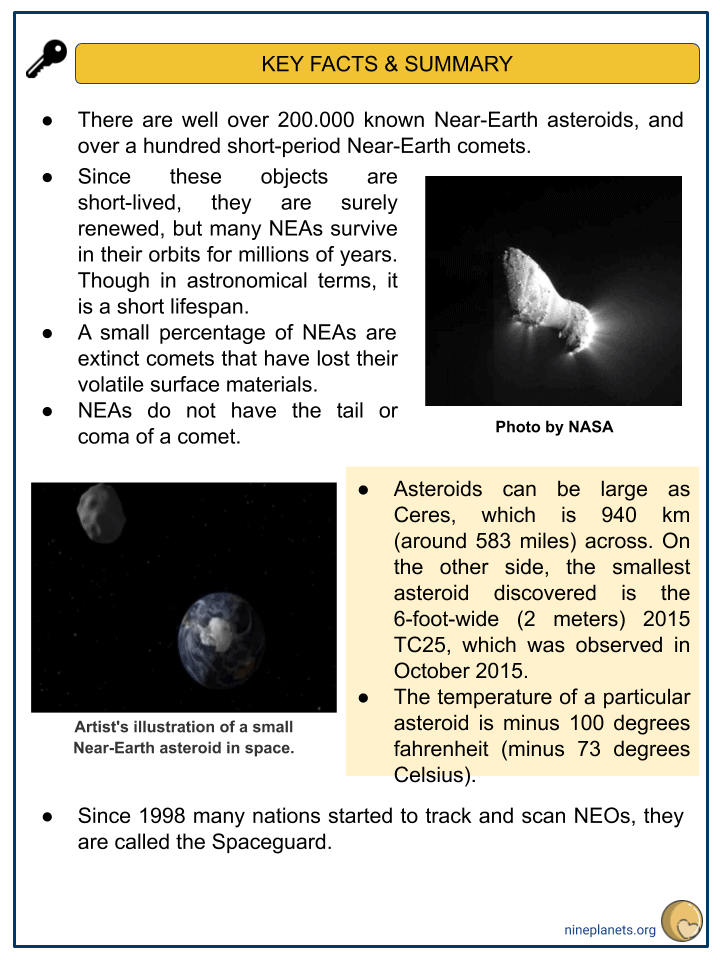
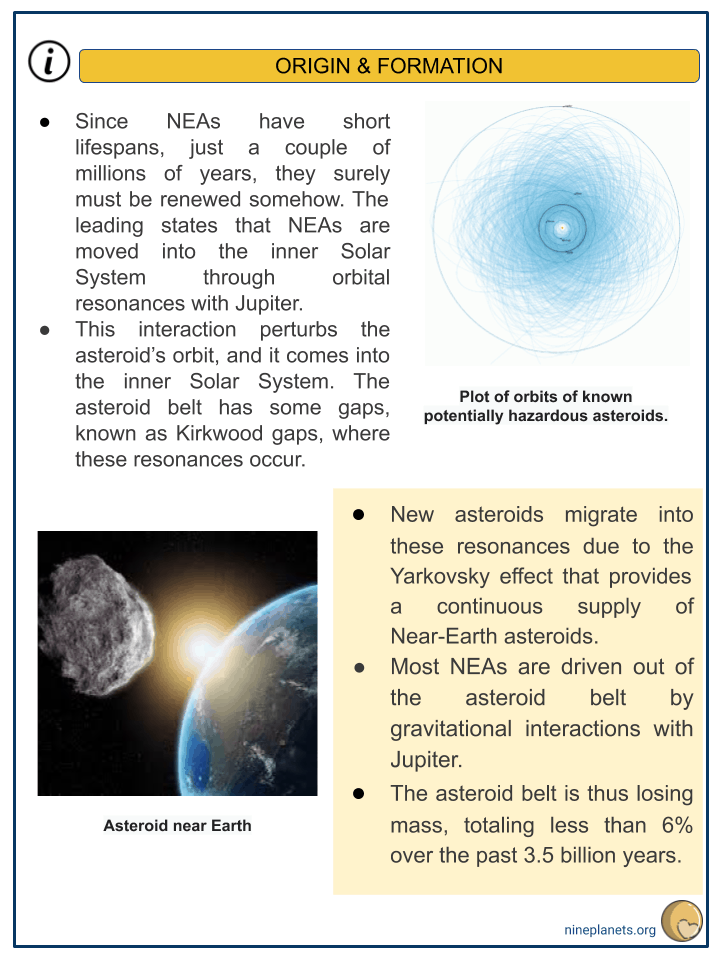
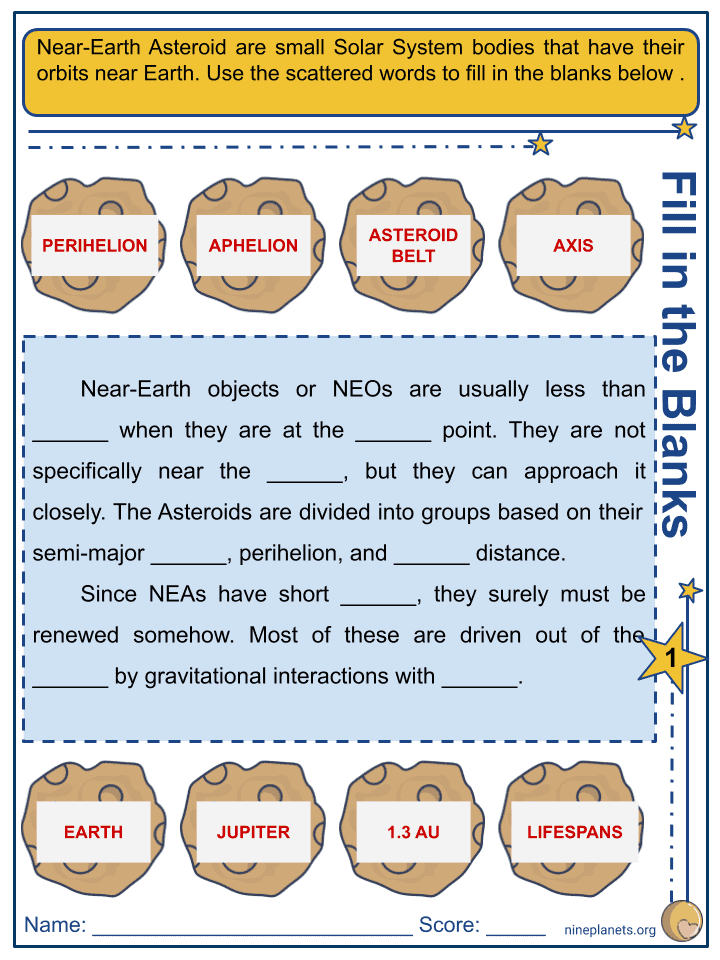
Key Facts & Information
- Near-Earth Asteroids or NEAs are small Solar System bodies that have their orbits near Earth. Near- Earth objects are usually between 0.983 and 1.3 Astronomical Units when they are at the perihelion point.
- Near-Earth objects, or NEOs, are usually less than 1.3 AU when they are at the perihelion point. They are not specifically near the Earth, but they can approach Earth closely.
- Some large asteroids have penetrated Earth’s atmosphere and caused various events such as tsunamis or huge craters.
- There are more than 19,363 NEAs currently known. More than 1,955 are potentially hazardous and have short lifespans.
- The Asteroids are divided into groups based on their semi-major axis, perihelion, and aphelion distance.
- Many of them are eliminated by planetary perturbations, causing ejection from the Solar System or a collision with the Sun or a planet.
Summary
- There are well over 200.000 known Near-Earth asteroids, and over a hundred short-period Near-Earth comets.
- Since these objects are short-lived, they are surely renewed, but many NEAs survive in their orbits for millions of years. Though in astronomical terms, it is a short lifespan.
- A small percentage of NEAs are extinct comets that have lost their volatile surface materials.
- NEAs do not have the tail or coma of a comet.
- Asteroids can be large as Ceres, which is 940 km (around 583 miles) across. On the other side, the smallest asteroid discovered is the 6-foot-wide (2 meters) 2015 TC25, which was observed in October 2015.
- The temperature of a particular asteroid is minus 100 degrees fahrenheit (minus 73 degrees Celsius).
- Since 1998 many nations started to track and scan NEOs, they are called the Spaceguard.
Origin & Formation
- Since NEAs have short lifespans, just a couple of millions of years, they surely must be renewed somehow. The leading states that NEAs are moved into the inner Solar System through orbital resonances with Jupiter.
- This interaction perturbs the asteroid’s orbit, and it comes into the inner Solar System. The asteroid belt has some gaps, known as Kirkwood gaps, where these resonances occur.
- New asteroids migrate into these resonances due to the Yarkovsky effect that provides a continuous supply of Near-Earth asteroids.
- Most NEAs are driven out of the asteroid belt by gravitational interactions with Jupiter.
- The asteroid belt is thus losing mass, totaling less than 6% over the past 3.5 billion years.
Sizes & Classification
- NEAs come in many different sizes; however, they tend not to be so big in comparison with other celestial objects. Very few of them have had their diameter measured accurately.
- One of the largest, 3122 Florence, has a diameter of 4.5 km / 2.8 mi, and it even has two moons of around 100 – 300 / 330 – 980 ft across, as companions.
- Predicting the exact number and sizes of NEAs has been a controversial topic for a long time. The latest reports from 2019 suggest that around 1.000 such objects have diameters of approximately 1 km / 0.6 mi, and more than 8.452 known NEAs are larger than 140 m / 459 ft in diameter.
- One of the smallest NEA is 2008 TS26; it has an absolute magnitude of 33.2, which equates to a diameter of around 1 m / 3.3 ft. On the other hand, one of the largest NEAs, 1036 Ganymed, has an absolute magnitude of 9.45 and a diameter of around 38 km/24 mi.
- Almost all of the asteroids are irregularly shaped, although a few of the largest are nearly spherical, such as Ceres.
Orbital Classification
- All NEAs are divided into groups based on their semi-major axis, perihelion, and aphelion distance. Four such classes exist:
- Atiras or Apoheles – have orbits only inside that of Earth’s. Their aphelion distance is smaller than Earth’s perihelion distance, which is 0.9 AU. This implies that these asteroids have a semi-major axis less than 0.9 AU.
- Atens – these asteroids have a semi-major axis less than 1 AU, and cross Earth’s orbit. Atens Asteroid is determined by having a semi-major axis. Aten Asteroid is also known as having an aphelion greater than 1 AU.
- Apollos – This class is the opposite, having a semi-major axis of more than 1 AU and also cross Earth’s orbit. Apollos were discovered by German astronomer Karl Reinmuth in the 1930s. Apollos are determined as having an aphelion same as Atens Asteroid.
- Amors – They have orbits strictly outside that of Earth’s. Their perihelion distance is greater than Earth’s aphelion distance (1.017 AU), this implies that their semi-major axis is greater than 1.017 AU. Some of these asteroids even cross Mars’s orbit. Also Amor asteroid 433 Eros was the first asteroid to be orbited and landed upon by a robotic space probe by the NEAR Shoemaker Spacecraft.
Co-Orbital Asteroid
- Some NEAs have a co-orbital configuration, which makes them have the same orbital period as our Earth. These co-orbital asteroids have unusual orbits that are relatively stable, and at the same time, it prevents them from getting close to Earth. Here are some examples:
- Trojans – In the orbit of a planet, there are five points of equilibrium named the Lagrangian points, in which an asteroid would orbit the Sun in fixed formation with a planet. Two of these points, L4 and L5, are 60 degrees ahead and behind the planet along its orbit. In these points, asteroids could reside for millions of years, even if perturbed by other planets and non-gravitational forces.
- Horseshoe Librators – Some asteroids run around both the L4 and L5 points, and if observed from Earth, their orbits resemble that of a horseshoe. Some may consist of annual loops that wander back and forth in a horseshoe-shaped area.
- Quasi-satellites – They are asteroids on a regular elliptic orbit, but with a higher eccentricity than Earth’s orbit. Thus, they travel in a way synchronized with our planet. The asteroids orbit the Sun slower than Earth when they are further away, and faster than Earth when they are close to the Sun. When observed from Earth, they appear to be in retrograde motion.
- Temporary Satellites – Some NEAs can change between solar orbits and distant Earth orbits, becoming gravitationally bound temporary satellites. These objects are typically caught when they pass the L1 or L2 Lagrangian points.
Impact
- The smallest NEAs explode in the upper atmosphere with most or all of the solids vaporized, while larger NEAs usually hit the water surface, forming waves, or on a solid surface, forming impact craters.
- The asteroid impact prediction is quite a new domain which has successfully predicted future impacts, yet, these predictions were rare.
The Future Near-Earth Asteroid
- There are many missions planned for the visiting of near-Earth asteroids. Some of them were intended as early as 1971. Currently, a sample taken from an NEA is expected to be delivered in December 2020 by the JAXA’s Hayabusa mission.
- Another spacecraft, OSIRIS-Rex, is also expected to return samples from some Trojans by 2023. There is also the Near-Earth Object Surveillance Mission or NEOSM – an effort to characterize the orbit of most of the potentially hazardous asteroids larger than 140 m / 460 ft. This mission is planned to be launched by 2025.
Did You Know?
- The first NEA to be visited by a spacecraft was 433 Eros; this occurred in 2001. As of 2019, 36 Atiras, 1,510 Atens, 10,199 Apollos, and 8,583 Amors have been discovered and cataloged.
- More than 19,470 NEOs have been discovered. Only 107 (0.55%) of them are comets while 19,363 (99.45%) are asteroids. There are 1,955 NEOs that are classified as potentially hazardous asteroids.